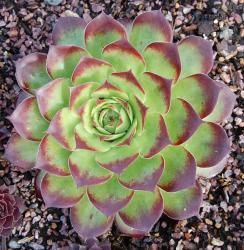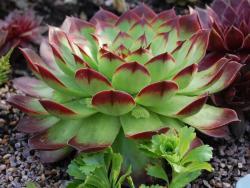1) Immediately but gently dig the plant out of the ground and remove all of the excess dirt. This should be done as soon as you identify you have a problem with rot. If the plant is in a pot, at least move the pot to a dry, but warm, area until you can follow this procedure. Always dry any sempervivum or jovibarba that starts to rot. If caught soon enough, you can usually save the plant. Literally, hours count - this is a time sensitive procedure.
2) Gently dunk the whole plant in clean water to remove any remaining dirt on the plant. Drain the plant on dry towels or paper towels. A microfiber towel works great for this. Be gentle but get the excess water off as soon as possible and don't wait for simple evaporation after washing.
3) Next perform preparation for surgery. Using fingers and eventually tweezers, carefully remove any leaves that show signs of rot anywhere on the leaf. Start from the bottom of the plant and work up. Try not to damage any of the exposed roots while doing this. Grasp the leaf firmly and pull horizontally to the plane of the leaf, which will be perpendicular to the direction of the root/stem that the leaf is attached to. The leaf should separate cleanly from the stem or root. Do this for all of the damaged leaves. You will expose something that looks a lot like a "carrot", but in the case of heuffelii, the carrot will have multiple tops, where the rosettes attach.
4) Immediately dry the "carrot" and associated rosette top. Remember, the rosettes might be very small after all the damaged leaves have been removed. Place the carrot in a warm, dry place, preferably with bright light for a few hours, until you are sure all the excess moisture from the dirt and washing procedure have evaporated.
5) When removing the leaves, you may have noticed a soft or squishy area of the "carrot-like" root/stem. That probably the rotted area. Visually inspect the plant looking for this area. The entire exposed stem may show or not show a soft discolored area.
6) Now the surgery. You will need a sharp knife and place to work. If you found a squishy area, then you will need to cut the plant in half vertically. Start at the base of the rosette and cut through the stem downward through the "carrot" trying to divide the carrot in half, straight thru the soft area so that you have two halves of the carrot. Reverse the cut direction and cut up through the rosette. If there is more that one rosette, choose your cuts so that you end up with one or more rosettes for each half of the roots, just as if you are going to divide the plant.
7) The purpose of the surgery was two-fold. a) It lets you actually see any damage that may be present in the stem of the plant (crown). and b) It divides the plant into two pieces, better increasing the chance that one may survive.
8) Inspect the cut area of the stem, crown and root for both pieces, keeping in mind that you are looking for the spot where the rotting leaves emerged from the plant. You should expect to see a damaged area extending into the stem, crown and/or root. One piece of the plant may be free from damage or not.
9) If the piece of the plant you are looking at is free from damage, then dry for a day and replant.
10) If the piece of the plant you are looking at shows damage from the rot, then you will need to completely cut out the damaged area from the healthy plant. If you cannot clearly see the damaged area and if the size of the plant 1/2 is big enough, cut the plant 1/2 into halves again to better see the damage. I do not recommend cutting smaller pieces that one quarter of the original plant.
11) Once the rot has been cut out, allow the plant pieces to dry and callous for a day, then plant in dry potting mix. After a few days, mist the plant for a week or two, then begin watering again.
If all goes well, that damaged plant can be saved and, its likely you'll end up with multiple plants where you had one before.
Remember, at the first sign of progressing rot, immediately dry the plant. I do not know why rot continues to progress until it kills the plant, but have had good success saving plants by drying rotting plants and cutting out the rotting pieces.
I had to do this with one of my heuffelii recently and took some pictures of the rot and the process. I'll post some pictures here to show this procedure in the next day or two.
-t


